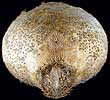The Echinoid Directory
Cionobrissus A. Agassiz, 1879, p. 206
[=Cionobryssus Meissner, 1903, p. 1343 (nomen vanum); = Cisnobrissus Bather, 1909, p. 22 (error)]
| Diagnostic Features |
|
|---|---|
| Distribution |
|
| Name gender | masculine |
| Type | Cionobrissus revinctus A. Agassiz, 1879, p. 206, by original designation. |
| Species Included | Only the type species. |
| Classification and/or Status |
|
| Remarks |
|





